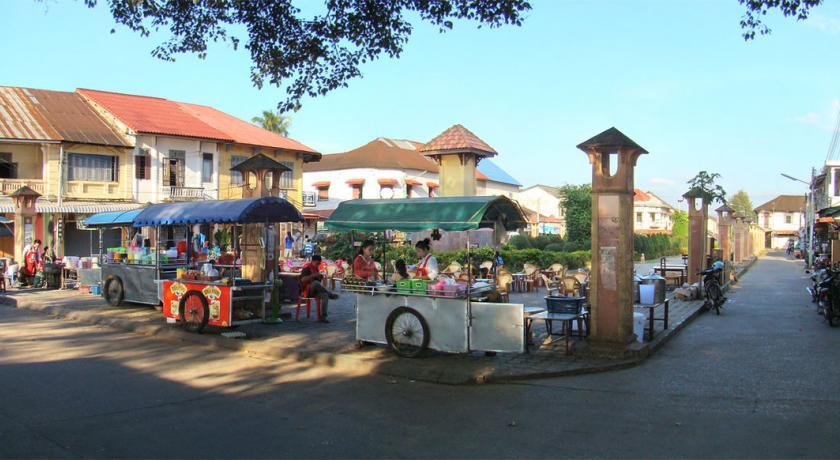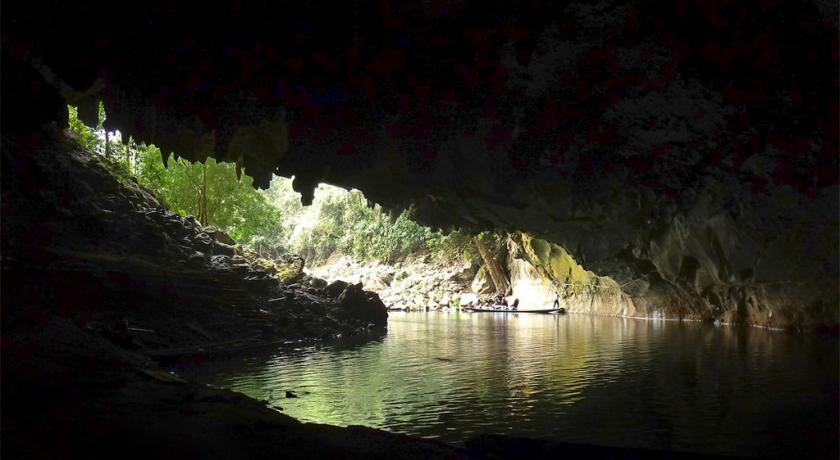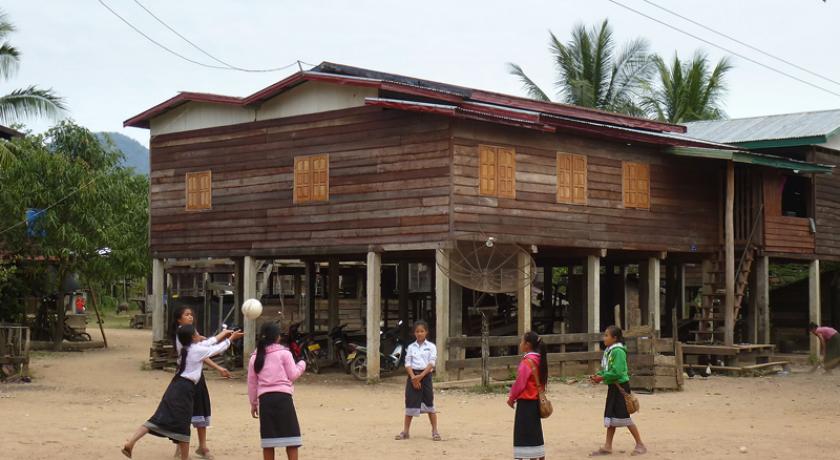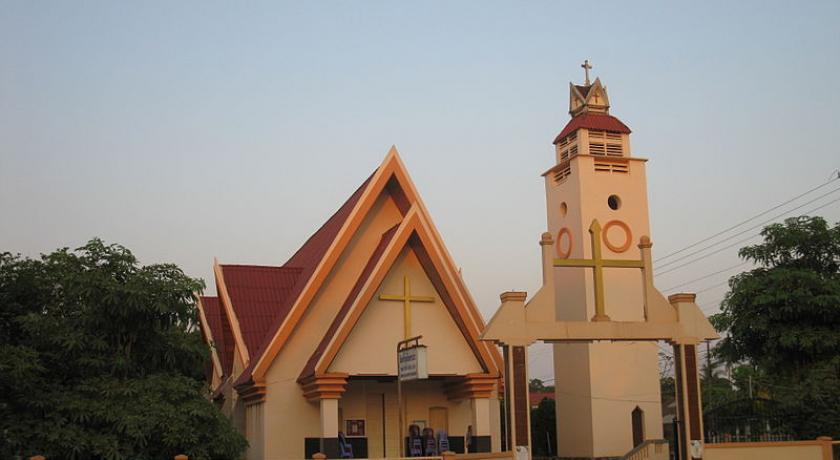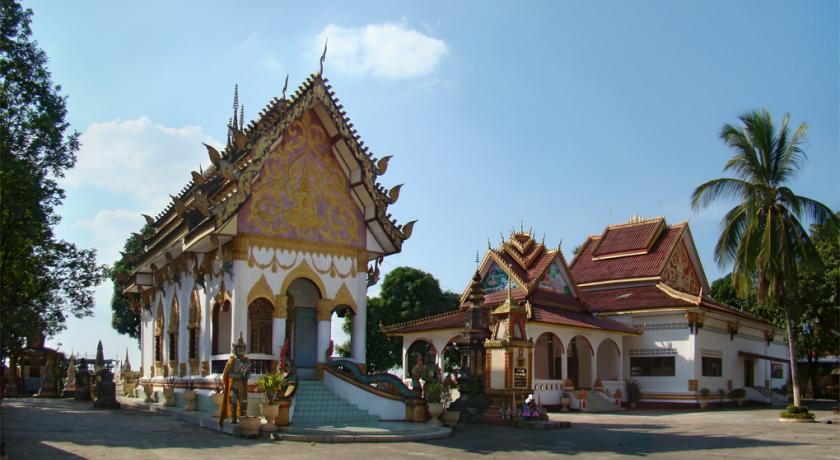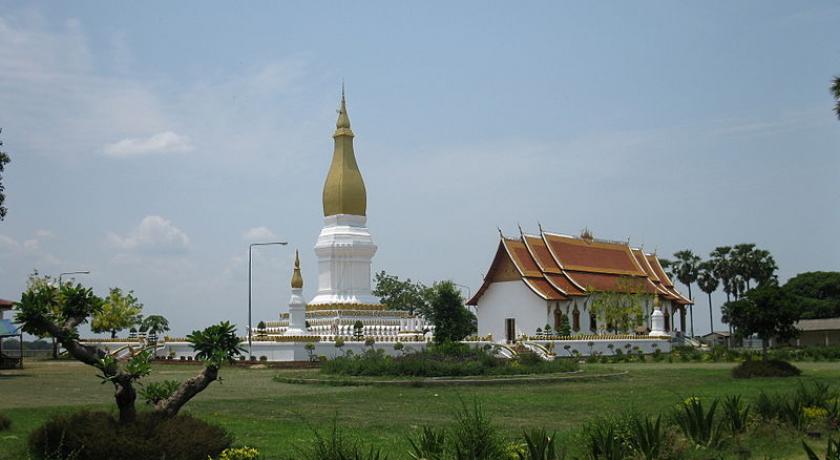Description
Khammouane or Khammouan (Lao: ຄໍາມ່ວນ) is a province of Laos, located in the center of the country. Its capital lies at Thakhek.
Many streams flow through the province to join the Mekong River. The vast forests of the Nakai-Nam Theun Biodiversity Conservation Area are an important watershed that feed many Mekong tributaries as well as form the catchment area for Nam Theun 2, the largest hydropower project in Laos. The Xebangfay, Hinboun and Nam Theun are the main rivers of the province.
Part of the aborted Thakhek - Tan Ap railway would have crossed the province to connect with the North-South Railway at Tân Ấp Railway Station, Quảng Bình Province, Vietnam through the Mụ Giạ Pass.
Demographics
The population of the province according to the 2005 census is 337,314
Geography
Khammouane Province, one of the provinces of Laos, covers an area of 16,315 square kilometers (6,299 sq mi) and is mostly of forested mountainous terrain. The province is bordered by Bolikhamsai Province to the north and northwest, Vietnam to the east, Savannakhet Province to the south, and Thailand to the west. Many streams flow through the province to join the Mekong River. Some of the major rivers which originate in the mountains of this province are the Xebangfay River (239 kilometers (149 mi) long), Hinboun River, Namtheun River and Namgnum River. Situated between the Mekong and the Annamite Range, the Khammoun Plateau features gorges, grottoes, jungles, limestone hills, and rivers.
Thakhek, the provincial capital, is situated along the bank of the Mekong River. It borders Thailand; the border check post is Nakorn Phanom in Thailand. The city has many buildings designed in the French colonial architectural style. The third Friendship Bridge opened to traffic on 11 November 2011 across the Mekong River. It is a major link between Thakhek city in the Khammouane Province and the Nakhon Phanom Province in Thailand. The bridge is 1,423 meters (4,669 ft) long and 13 meters (43 ft) wide.
Economy
Thakhek, the provincial capital, is an important centre for trade. Along with Bolikhamsai and Savannakhet provinces it is one of the main tobacco producing areas of Laos. Part of the province, particularly Yommalath District, was badly affected by floods caused by heavy rain in July 2011, affecting rice farmland in the district, inundating almost 700 hectares, destroying dozens of fishponds and killing 112 cattle. There are several major operating mining companies in the province, including Mining Development Economy Corporation mining gypsum in Thakhek District, LAVICO Co. Ltd, which is a Laos-Vietnam joint venture mining gypsum in Xebangfay District, V.S.K. Co. Ltd mining limestone in Thakhek District), and Lao-North Korea Tin Mines mining tin in Hinboun District. Several culinary specialties are also native the province including Kha Nom Phane, a type of rice cake.
Protected areas
The province's forest areas consist of three reserve areas. These are the Nakai - Nam Theun National Biodiversity Conservation Area (NBCA), which covers an area of 352,200 ha of the Annamite mountains and the adjacent Nakai Plateau in the provinces of Khammouane and Bolikhamxay, the Hin Nam No National Biodiversity Conservation Area with an area of 86,229 ha, and the Phou Hin Poun National Biodiversity Conservation Area with an area of 150,000 ha. These forests have many natural caves.
Tham Khonglor Cave (meaning: “Beauty in the Dark”) is part of the Nation Protected Forest Area in Hinboun Mountain. Its west entrance is from Ban Khonglor village in Hinboun District, while the east entrance is from Ban Natan village, Nakai District. The cave runs for a length of about 7.4 kilometers (4.6 mi) and its width varies from 10 meters (33 ft) to 90 meters (300 ft). Its height is in the range of 20 meters (66 ft) to 100 meters (330 ft) and the Hinboun River flows through the cave perennially. Vang That and Had Xay Luang are the two hanging rock formations in the cave. Had Xay Luang is a white sand beach here, of about 150 meters (490 ft) in length and 100 meters (330 ft) width. The cave is approachable along two routes, one from Vientiane along Route 13 to Hinboun District, and the second route is by boat along the Hinboun River
Animals
In 1996, western scientists discovered a rodent in Khammouan representing a mammal family that had been previously known only from fossils. The Laotian rock rat or kha-nyou (Laonastes aenigmamus), also called the "rat-squirrel", was formally described as a new species in 2005. The species was first described in a 2005 article by Paulina Jenkins and coauthors, who considered the animal to be so distinct from all living rodents. They placed it in a new family, Laonastidae. It is in the monotypic genus Laonastes.
Species of mammals, some discovered relatively recently, include the following (Robichaud 2005): saola, giant muntjac, Roosevelt's muntjac, Truong Son muntjac, Indochinese warty pig, Heude's pig, Annamite striped rabbit, Javan rhinoceros (Rhinoceros sondaicus annamiticus), Indochinese tiger, and Asian elephant.
Important Bird Areas
The 68,125 hectare Hin Nam No (also Hin Namno) Important Bird Area (IBA) is within the Hin Namno NBCA. Its topography features limestone karst outcrops, undulating limestone hills, as well as valleys. The IBA's habitat is characterized by sparsely vegetated limestone karst, semi-evergreen tropical rain forest, mixed deciduous forest, moist deciduous tropical forest, and wet evergreen forest. Crested argus (Rheinardia ocellata) and Austen's brown hornbill (Anorrhinus austeni) are classified as near threatened. The inornate squirrel (Callosciurus inornatus) has been identified as important fauna within the IBA.
The Khammouane IBA is situated within the Phou Hin Poun NBCA. The IBA is 79,000 ha in size and its altitude is 200–900 meters (660–2,950 ft) above sea level. The topography and habitat are characterized by sparsely vegetated limestone karst, semi-evergreen forest, mixed deciduous forest, as well as non-calcareous substrate. The IBA is notable for supporting the sooty babbler (Stachyris herberti) and a taxon of François' langur (Trachypithecus francoisi).
Landmarks & Attractions
That Sikhottabong, also known as Sikhottabong Stupa, is contemporary to That Inhangin Savannakhet and That Phanom, built in Thailand under the Sikhottabong Empire. The bones of Lord Buddha are said to be consecrated in these temples. King Nanthasene built the stupa for King Soummitham. It was refurbished in the 15th century during the reign by King Saysethathirath. The stupa has four squares with each side measuring 25,030 meters (82,120 ft) long and its base is 14.33 square meters (154.2 sq ft) and rises to a height of 29 meters (95 ft). The pinnacle appears in the shape of the banana flower. The stupa is seen on the bank of the Mekong River. The festival held at this location is during the third month according to the lunar calendar.
The Great Wall, built of stones, starts on the west side of Thakhek. It is 8 kilometers (5.0 mi) from the city, on Route 13. It extends from the Namdone River and its total length is about 15 kilometers (9.3 mi). Some sections of the wall are seen in Thakhek also. Its construction is attributed to the period of the Sikhottabong Empire in the 19th century and is now proposed to be preserved as a national heritage site.
Other attractions include:
- Tad Kham Waterfall (about 52 kilometers away from Thakhek District).
- Tad Nam Khengkam Waterfall (about 37 km away to the east of Thakhek District).
- Wat Pha Sokkhamsene Temple (an old temple near Nongbok District and about 37 km from Thakhek District).
- That Thumphavang Stupa (to the north of Nongbok District).
Do
Thakhek The Town: the old parts of Thakhek near to the Mekong provide good views of Thailand, albeit at quite a distance. Along the road adjacent to the river there are small and large hotels, restaurants, and curbside food vendors, even a few fun stalls such as air rifle shooting. The restaurants extend back a block or two from the river. Bicycles and motor bikes can be rented from various places so that you can get around more easily. Wifi is available at a number of restaurants and there's an internet cafe for those who need it.
The market hidden behind the shops on the roundabout corner oppositely the Lao Development Bank is well worth a visit. Narrow lanes wind between the shops leading to a large open market selling fresh produce and sometimes unusual meats such as snake, squirrel, frog and bat.
Konglor Cave is likely to be the highlight of this area if not the whole of Laos. There's a 7 km cave through which a navigable river passes. Motorized long boats take visitors through the cave to view the caverns and limestone formations. One section is undertaken on foot and is lit up while the rest is viewed with miners' lamps. The far end emerges into a lush valley where in peak periods locals sell products. In the dry season you might also have to get out while the boatmen drag the long boat over the shallows. In the wet season (and often at other times) there will be water dripping from the roof so you should wear appropriate clothing and be prepared to cover your cameras. The cave is situated in the Phou Hin Bun National Park for which there's a 2,000 kip entrance fee. The fee to visit the cave entrance is 10,000 kip and the return trip through the cave in a longboat costs 120,000 kip for two people (130,000 for three, 110,000 for one) so you might want to consider grouping with other visitors to minimise the cost. The road to Konglor leads is mostly OK but some sections are seriously in need of repair (probably always one section or another will be pot holed) and runs through a valley with rice and tobacco fields. Ban Nahin village on route 8, 42 km from Konglor, has several guest houses and some motor bike rentals. There are about 5 guest houses and a few restaurants near Konglor.
Using scheduled public transport is not easy and most people use an organised bus or car to travel to the cave. Even then it is at least a three and a half hour trip each way and you will normally be three hours at the cave, more if you eat out there.
The Loop, as it has become known, is a few hundred kilometers circular tour starting on route 13 to the east and then back up and around returning on route 12 from the south. It is normally done in three to four days on a hired motorbike though a few enthusiasts rent mountain bikes. Either way it is not for the faint hearted the condition of the roads and the driving standards make driving challenging. Once you have washed all of the thick orange dust out of your hair and clothing it is hard not to feel a great sense of achievement in having completed it. There are guest houses along The Loop: town guest houses and motor bike renters can provide more details.
Carrying a spare bottle of fuel gives a sense of security and might well make your day, as there are long stretches without fuel stations, and ascents increase fuel consumption. Road #1E, the section between Yommalat and Laksao (around 80km), while very rewarding, is a dirt track with lots of deep potholes filled with mud, especially after the local heavy rains - enjoy responsibly. Indeed, during rainy season there is a 5km stretch that is all but impassable on motorbikes unless you are very skilled at identifying the least muddy route, or have a local to follow. As a general rule, stick to the deep tire ruts rather than skirting around the edge where the mud is thick enough to clog up your engine and jam your wheels.
Reasonable places for overnights on an anticlockwise trip could be the Sabaidee Guesthouse in Tha Lang (after 99km without cave watching), and maybe a home stay/guesthouse near Konglor cave (after another 145km), before an early visit there and return to Thakhek (another 185km), making it an enjoyable three-day trip.
There is a number of very informative scrap books filled with tips, maps and others experience on 'The Loop' in the Travellers Lodge in Thakhek
The Budda Cave Tham Nong Pafa Cave is on the southern leg of The Loop or directly from Thakhek. Allow a full day if going all the way to Aen Cave by bicycle and at least half for a visit the signposted Budda cave which is about 15 km from town, the last nine being a dirt road that winds through some stunning limestone scenery.
Tha Falang is a river swimming spot about 15 km east along route 12, though it can be disappointing in the dry season but the ride and friendly children still make this trip good fun. It is not signed in English so you will need to have clear instructions when to turn off to the north down a sandy track second after the bridge before the road bends around to the right between two cliffs. Immediately south after the bridge there is a shady spot to park and you can follow the river to Tham Xiengliab, a small cave with the river flowing through it. Again a guide or pack of children will probably appear to guide you. Bring a torch if you want to go inside. It’s about another 4-5 km to the commercialised Aen Cave which is lit with a rainbow of neon strip lamps and has an amazing network of staircases. It has a river running out of the mouth and a big pool at the back: it is worth a look for the stair cases alone. Warning- lock everything in your motorbike. Thefts have occurred here
The Nam Theun 2 Visitors' Center welcomes visitors to learn more about this innovative hydro-electric power project at the foot of the escarpment of the Nakai Plateau located 70 km from Thakhek by taking road 12 to Gnommalath. The center consists of an exhibition room and a theatre, and has a commanding view of the power house from the terrace. The exhibition room has panels and physical models that provide a welcoming and educational environment to learn more about the Project and the key role it plays in the economic and social development of Laos PDR.
Visitors can discover more about the project from the development phase to operation through various documentary films screened in the theatre room. Brochures and publications are also available at the center and staff is available to give explanations or answer questions. The center is open from Monday to Saturday 8:30 – 12:00 and 13:00 – 17:00 with free entrance.
Eat
A number of cafes and food stalls line the riverfront road serving the usual types of basic food. Elsewhere there are many such places selling similar food as well as hot pork rolls in baguettes at some take away lunch stands. At night just a block from the river, food stalls sell various types of pancakes and pork buns by battery powered lamps.
Great cheap BBQ meat can be found almost all day long (not in the morning) in the centre parts along Mekong riverside.
Sleep
There are more hotels and guest houses in Thakhet than listed here. They are scattered around the town rather than being close to each other but most are in the Mekong area.
- Khammouane Inter Guesthouse, (on the main road, about 200m south-west of the post office), ☎ 051 212 171. checkout: 11:00. With the charm of an administration building from another era, it is not going to win any style competition, but is popular with backpackers for its fair priced basic rooms, a spacious lobby with free internet (1 PC), wifi throughout, and it is an important element of the limited range of accommodation in town. Helpful staff offer guidance for 'The Loop', the Konglor cave and bus travel. Free luggage storage. And cooler with free drinking water in the lobby.
- Thakhek Travelers Lodge, (1km south of the roundabout, from the market about 400m further east coordinates: 17.397565, 104.824950), ☎0305300145. Very Basic.
- Inthira Hotel, 79, Unit 4 - Anou Road, Thakhek (Located right in the city center, close to the Mekong), ☎ (00856) 051 251 237. The Inthira Hotel is part of a chain. It has lovely rooms and an excellent restaurant offering international and Lao cuisine - great place to meet other travelers. Wi-Fi available in common areas and rooms as well as computers for guest use. Bicycle and motorbike rental. Up market. $29 Basic/cheapest room High Season (March) 2015.
Rooms at the hotels by the riverside start at about 100000 kip.
Get in
From the North: Buses from Vientiane leave the Southern Bus station every 1-2 hour in the morning, the journey takes around 7 hours. There are hotel pick-up buses that can be booked from the centre of Vientiane but they make quite a mark up from the bus station. The long distance bus station is situated about 5 km east of the city centre along the Mekong, so a tuk tuk ride is almost unavoidable if you do not use the hotel pick-up service.
From Pakse it's a 10 hour ride (don't believe the signs saying 5) in the local bus (update April 2015, the ride can vary it depends on whether conditions and how many stops/delivery the driver does along the way so between 5-10 hours). Including pickup it's 90000 kip (Jan 2015). Probably cheaper direct at the bus station (April 2015 60,000 kip at the bus station).
Get out
Bus
There are two bus stations: one near the city serving the more local rural communities and a larger one about 5km to the north serving inter province and some international journeys.
Get around
Thakhek town is small enough to walk around but tuk tuks will take you most places for prices from 40,000 kip (less for locals).
Update Nov 2015--------- Never pay 40.000 kip it s a huge amount for locals. You should be able to negotiate and you go everywhere for 20.000 kip A tuk tuk to / from the bus station typically costs 20,000 kip per person (more for just 1 or 2 persons) and takes about 15 minutes.
Update 2015------ Run away from bus station to the city and you will find a tuk tuk for 10.000 kip. In the bus station tuk tuk ask for 30.000 and then after negotiation 20.000 kip.
Bicycles and motorbikes can be hired from a number of places, mostly in the more touristy area near the Mekong.
Source: https://en.wikipedia.org/wiki/Khammouane_Province
http://wikitravel.org/en/Thakhek
Address
Khammouane Province
Laos
Lat: 17.638406754 - Lng: 105.219482422


